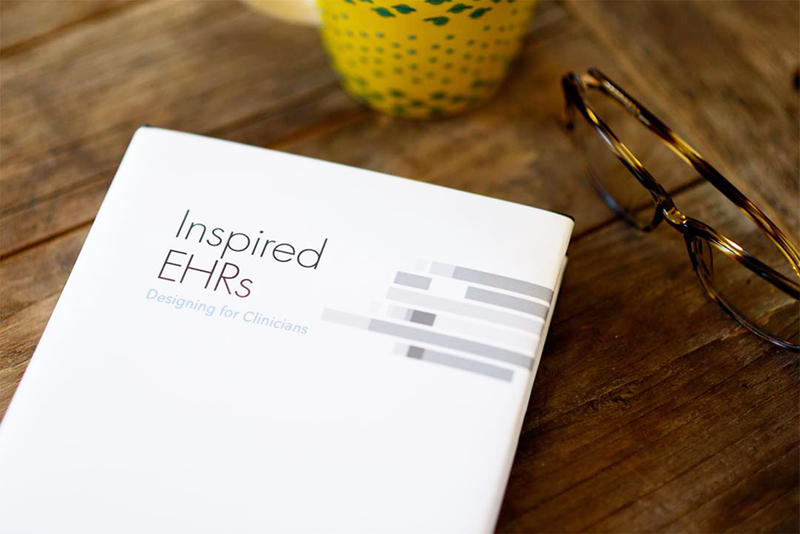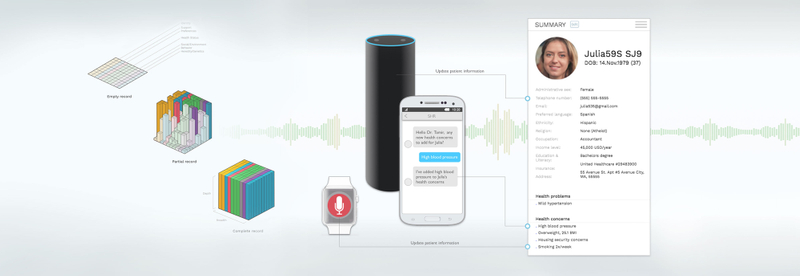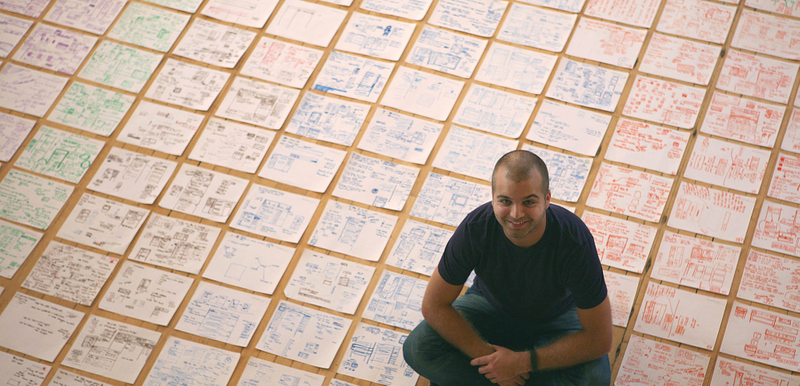
Natural language processing (NLP) software for hospital coding
for 3m
Problem
CodeRyte wanted to take their “bolted-on” coding service, and transform it into a complete package service to dominate the coding market for hospitals.
Solution
Starting with a shorter proof of concept period, GoInvo designed a comprehensive service with built-in automation to drastically increase efficiency in hospital coding.
Results
Memorial Hermann Hospital saw a 200% increase in coding efficiency and productivity.
Time: 2 designers and 1 engineer for 15 months
Tags: Health IT & infrastructure
Background
Glenn Tobin has a vision
Glenn’s company, CodeRyte, had a profitable niche providing coding software to hospitals. But they were seen as a “bolt-on” service, another piece of software in an already complicated process. People liked CodeRyte, but wished they didn’t have to use it. The profits were nice, but it was not the sort of business model to get excited about each morning.
However, Glenn and his executive cohorts saw a bigger opportunity: to take over the complete coding experience at hospitals. They had the industry expertise and know-how, but taking their more narrow software and transforming it into a best-in-class silver bullet for hospital coding requirements was a massive software challenge. To solve it, Glenn called GoInvo.
 Glenn Tobin, COO, CodeRyte Inc.
Glenn Tobin, COO, CodeRyte Inc.
Software that handles $4B in revenues ain't no joke.
You and I are familiar with the open-backed gowns and terrible food, but what you might not be familiar with is how information moves inside the hospital, and how that pertains to billing. For the hospital to get paid, they must tag each record with unique diagnosis codes. Lots and lots of codes that drive insurance reimbursement. All of this is a manual process done by an army of “coders” at the hospital.
 One of the unsung heroes that makes the healthcare system run.
One of the unsung heroes that makes the healthcare system run.
Coders are hardcore. They rely on their coding software six days a week, from 9-to-5. Sitting at the terminal, coding in for so many patients and what seems like countless relevant codes. CodeRyte provided part of their solution before, but the vision now was to offer the entire system —a system where dollars are counted in keystrokes. The fewer keystrokes to accomplish the same end task, the more profits for the hospitals. The faster those fewer keystrokes can take, the profits add up even more. Not to mention happier coders.
Process

The challenge was big, so we started small.
Having designed over 50 major enterprise applications, we have a pretty good sense about how deploying great software needs to happen. Rather than crafting a high six or even seven figure engagement, we proposed a proof of concept —eight weeks of a small GoInvo special forces team going in deep with the core CodeRyte crew. This would breathe life into the idea, get us deep into the vertical space, and let both sides kick the tires on working together.
We got into hospitals; got into the coding environment. We became conversant in CodeRyte’s software and the general software environment. That’s the invisible stuff. Then we started making our peculiar brand of magic. An initial proof of concept was produced.
In a mere eight weeks, our research and design efforts brought to life the vision Glenn and his colleagues knew was possible.
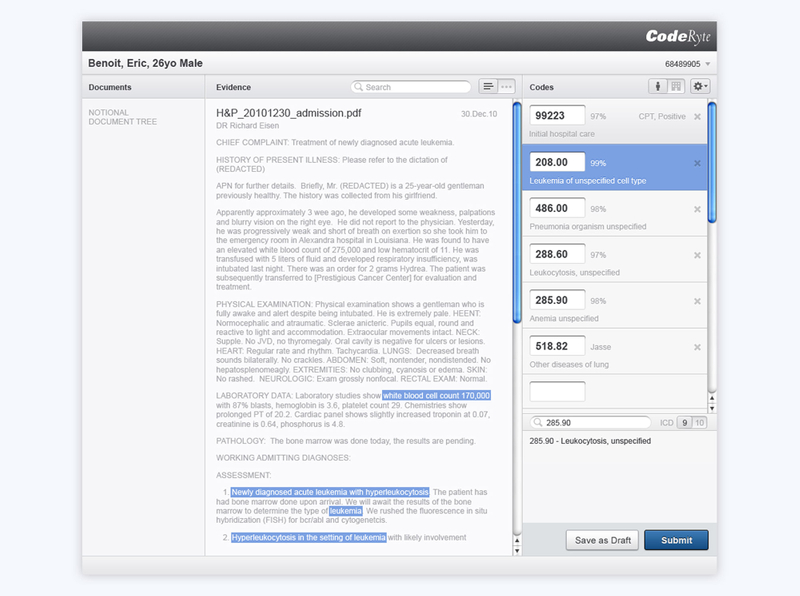 Document timeline concept: Coders can quickly see the size of the encounter plus the amount and location of evidence found by the Natural Language Processing (NLP) algorithm.
Document timeline concept: Coders can quickly see the size of the encounter plus the amount and location of evidence found by the Natural Language Processing (NLP) algorithm.
When they first saw our work, the CodeRyte executives lit up. They knew this problem could be solved, but the chasm from vision to manifestation can be a daunting one. Here, now, in our work, the translation was made scintillatingly clear: this idea had big-time legs. Not only did it prove the concept it gave them something that would make sense to their investors, their board, their stakeholders —everyone. The future of CodeRyte was not grand ideas. It was this, here: gorgeous screens that solve dozens of problems faced by users of this type of software.
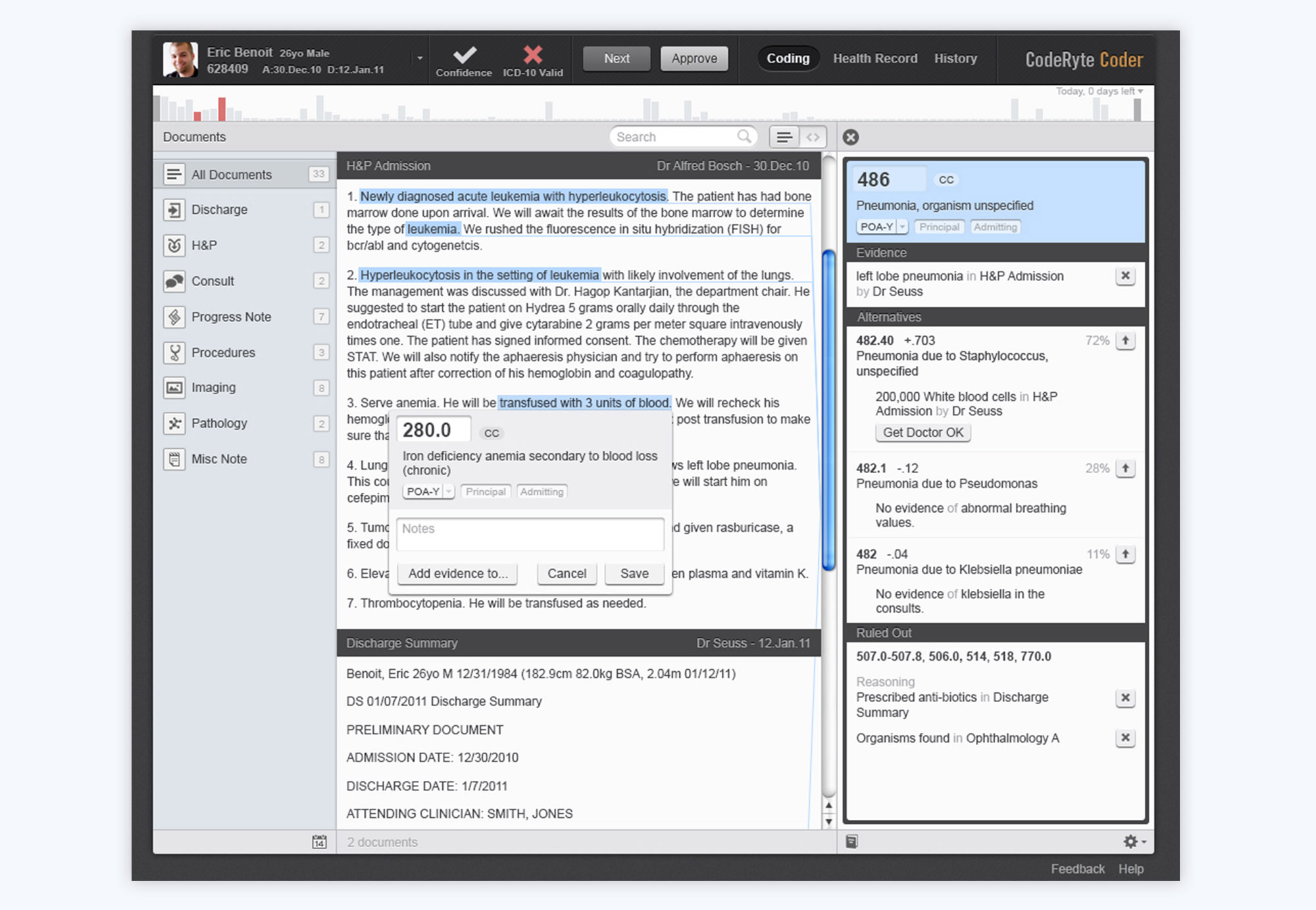
We created over 15 different prototypes to test and iterate on our ideas and feedback.
We needed to make sure we could do this. Invo proved we could. We needed to make sure we could sell this. Invo gave us the tools to do that, too.
George Moon
VP of Product, CodeRyte Inc.
With CodeRyte galvanized behind the project, we started a new (again: small) 12-week project to make a working prototype. Evolving the design, getting in actual data, and as fully working web-based software. Not only did this improve the platform for the full design and implementation to come, but it also gave CodeRyte an exceptional sales tool that reinforced this would be real —not vaporware.
Orders quickly followed.
Going Live
Reality sets in: the first customer
Memorial Hermann is a large not-for-profit healthcare system in Texas with 12 hospitals. They saw the potential of what CodeRyte was planning and signed up. More than being a first customer, they wanted to be a partner. That is the very best kind of customer.
By this time we were well on our way with a full design project. Our team of three designers and engineers worked as a unit with CodeRyte’s team of ten, including executives, subject matter experts, product managers, and engineers. While the unified user experience was a big part of the project, it was brought together with CodeRyte’s amazing NLP technology which helped automate parts of the patient coding process.
Two months into the full design project we had an evolved prototype used not just by our team’s and CodeRyte’s, but Memorial Hermann’s as well.
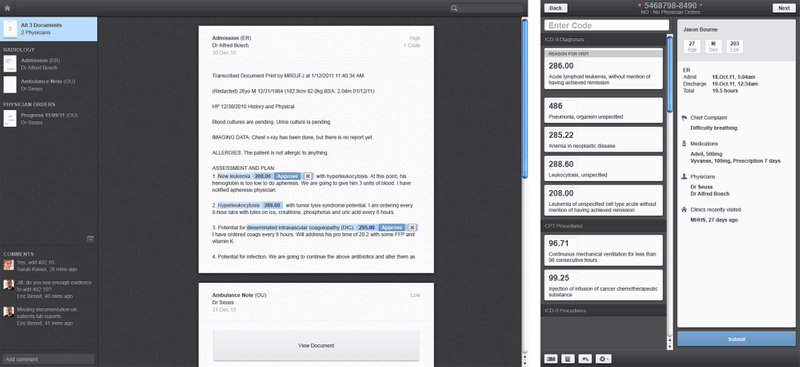 Progress came quickly in our rapid prototyping model, benefitting our clients and their customers from the earliest weeks.
Progress came quickly in our rapid prototyping model, benefitting our clients and their customers from the earliest weeks.
Transparent development + rapid feedback = Yum!
With the ability to quickly give us feedback on the software in the first prototype, Memorial Hermann was conditioned to provide quality feedback from the start. Our design process was infused with daily feedback. As we would update the software in real-time, the customer would communicate back to us in real-time. Our software pros know not to make changes just because a user asks for them, but synthesizing the feedback of real users with our decades of expertise in software design enabled us to leap far ahead in the crafting process, leveraging the knowledge and experience of our customer-partners. Not only was the work better, it was fun for us all.
Through this process we re-wrote the coding panel three times, in a fraction of the time it takes a typical user experience process to work. We would start in the morning with user feedback and go through a process of review, design swarm, sketch, implement and, by the end of the day, release.
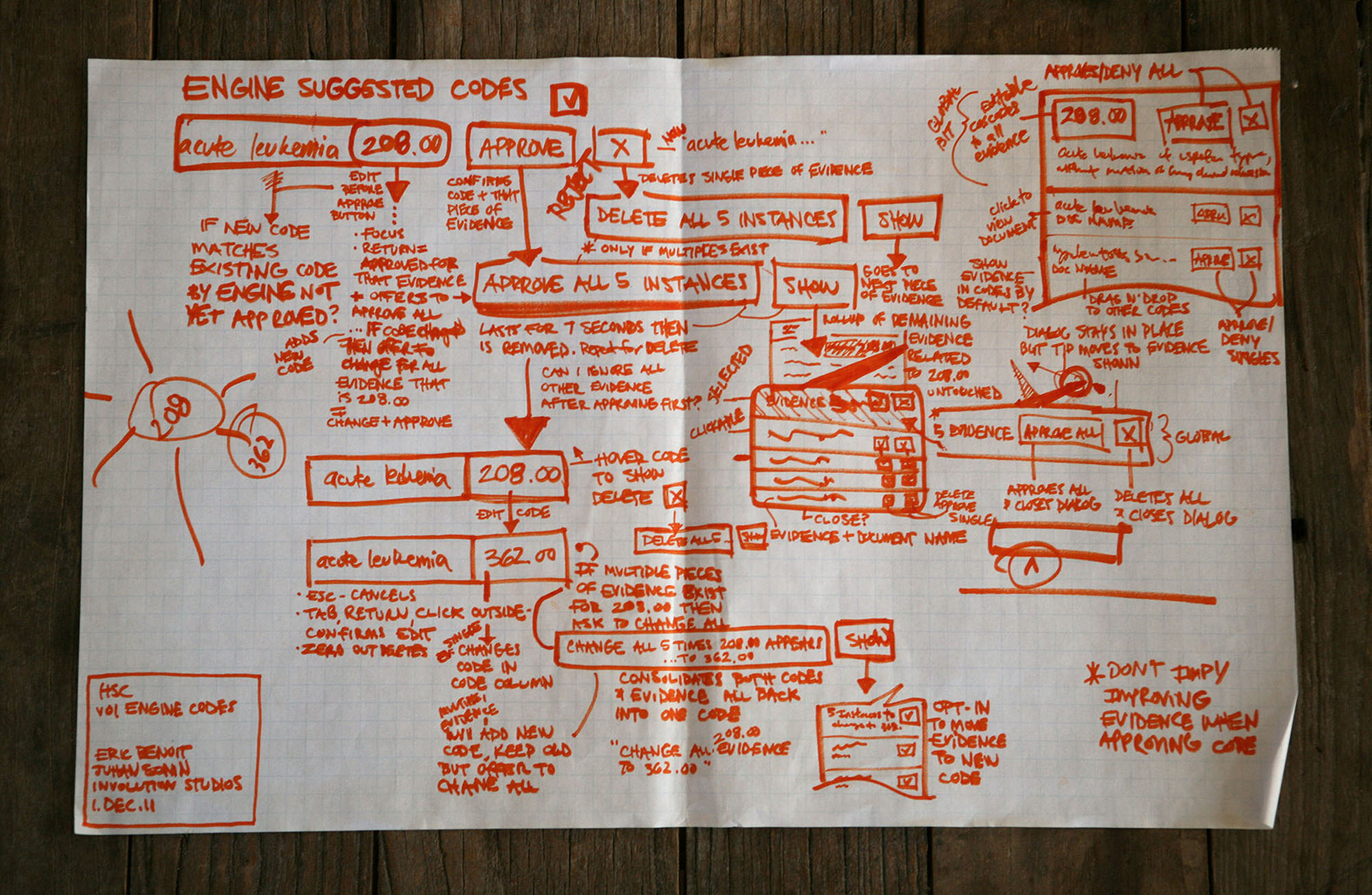 Sketch to staging in mere hours. Allowing us to get our touchable ideas in front of real users for immediate feedback
Sketch to staging in mere hours. Allowing us to get our touchable ideas in front of real users for immediate feedback
During this process, a funny thing happened: Memorial Hermann’s team became passionate about CodeRyte. They felt ownership in both the process and the software. Of their own volition, they became vocal advocates for CodeRyte. This translated into adoption and training savings that were significant for themselves as well as CodeRyte, while making everything about the project feel good for everyone involved. The same thing was happening at CodeRyte, where the speed at which we moved, in sync with their development team, as well as key customers galvanized everyone around not just the project but the future of CodeRyte. It was time to dream big.
Serendipity: fine-tuning the business
The supercharged software we made for CodeRyte quickly generated revenues an order of magnitude higher than our fees. Even more than that, we proposed new lines of business to extend their reach with a more nuanced product suite, helping to drive long-term strategy.
 Many concepts were tested for understanding coder and hospital productivity.
Many concepts were tested for understanding coder and hospital productivity.
The trouble with technology.
Hospital software is dated. As in, Thomas Edison might have been designing his first light bulb when that stuff was deployed. Once miraculous, now these legacy systems and code stand as feisty gatekeepers for their self-preservation, trying to prevent the deployment of something to replace them.
But it was more than just getting around and replacing the old software; it was building in ways to maintain some of the legacy systems —different legacy systems depending on the hospitals. It was HIPAA. It was security with PHI. Each of those is a challenge, and, put together, the problem multiplies.
CodeRyte’s fantastic internal staff did a lot of hard work on this stuff. So did we. In the design strategy as well as execution and interface engineering, we worked together to not just create great new software in a vacuum (which is hard enough) but to do so in this Byzantine ecosystem. And we have to admit: the team actually enjoyed it.
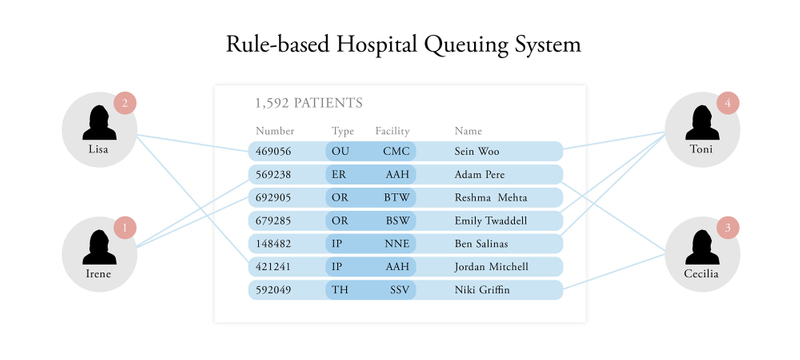 Serendipity: entire workflow is improved
Serendipity: entire workflow is improved
CodeRyte thought they were bringing us on to manifest and extend their software vision. They didn’t expect us to re-imagine workflow that changed the entire queuing ecosystem for thousands of hospitals.
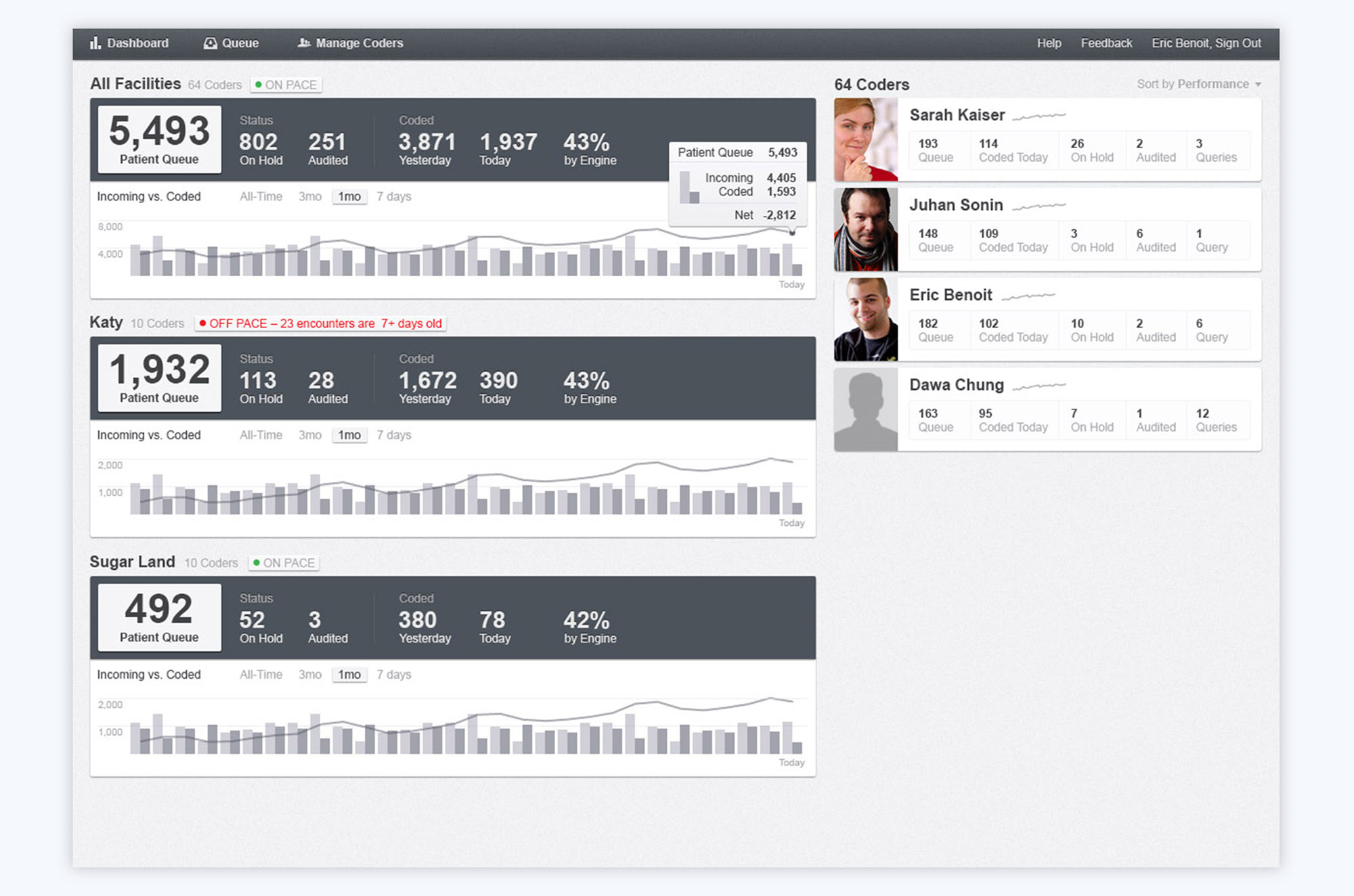
Good things come to those who rock it.
As design shifted more into engineering and implementation, more than a year passed. The launch was getting close, and the teams at Invo, CodeRyte, Memorial Hermann and now 250 other major customers were excited: healthcare coding workflow was going to change for the massively better. But we weren’t the only ones watching and excited.
So was 3M.
The $30B company was a partner of CodeRyte’s for the past three years. Partnership was fine when CodeRyte was offering a tool that augmented the many things 3M brings to market. But once 3M realized CodeRyte was about to see through radically changing their market a partnership was no longer enough. So they opened their wallet to the tune of $146MM to make the 125-person CodeRyte Inc. an integrated part of their global offerings.
CodeRyte’s executives were thrilled to be rewarded for their hard work while having the chance to deliver their vision via a much larger delivery vehicle in 3M. As you might imagine, CodeRyte’s board and investors were pretty thrilled as well, greatly exceeding their multiples.
GoInvo just handled our customers for us.
Robert Schulz
CodeRyte Inc.
P.S. the Morning After
About two weeks after launch, CodeRyte got a frantic call from the lead manager at one of their largest customers. CodeRyte had completely stopped working in the middle of the coder’s shift. Our team was simultaneously getting a flood of emails via the app’s feedback mechanism: no patients were entering the system to be coded.
Our team and CodeRyte’s jumped in together to try and figure out what was wrong. Why were no patients loading into the system? Downtime is an enormous issue for this multi-billion dollar customer. Within 30 minutes we discovered the problem: there were no patients left to code. The software worked so well that the backlog of coding was passed and there was, for a period of time, no more work to do.
Never in the history of this hospital system had this happened. The efficiency of the software turned the bureaucratic quagmire of massive backlogs of patient coding into a just-in-time system that required less manpower and delivered faster results.
Your team kicks ass!
George Moon
VP of Product, CodeRyte Inc.
The hospital system has since been able to change their procedure and conservatively estimates a 200% increase in efficiency in their coding workflow.
Maybe SAP will buy 3M just to get control of CodeRyte. With productivity gains like this, who wouldn’t?

